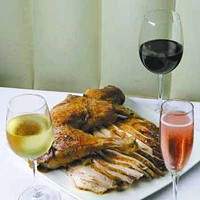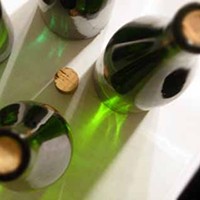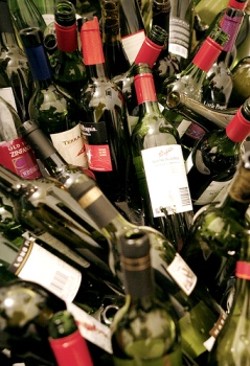Holiday parties present a plethora of "impress people" possibilities. Wine knowledge delivered with confidence can bring out your "inner coolness," as well as shut down that verbose braggadocio trying to abscond with your date. Armed with a wine label, take over the scene with these urbane tidbits, both useful and trivial.
Vintage
Most wines carry a vintage date, meaning at least 95 percent of the grapes used were harvested in that year. Varying weather has a huge impact on a wine's quality and complexity, especially in areas with often severe conditions and growing restrictions, such as France. Sunny and warm California and Australia enjoy consistent weather and fewer government hassles about vineyard management, so vintage dates don't matter as much. Cool factoid No. 1: 2005 was an outstanding vintage across France. Cool factoid No. 2: Most Champagnes and sparkling wines are non-vintage, indicating a blend of wines from several years.
Appellation/American Viticultural Area (AVA)
The appellation (or AVA in the U.S.) tells you where the grapes were grown, pointing out the distinctive qualities of the soil and climate in that particular region. Those in the know call this concept "terroir" (pronounced "tare WAHR"). Practice this French word -- it's got a high hip quotient. European countries like France and Italy (aka "Old World") label wines based on region rather than grape variety, realizing one vineyard can exhibit a drastically different personality from another 50 yards (or 47 meters) away. Thus a Burgundy, despite its reddish reputation, can be a pinot noir or chardonnay, and a bottle called Corton can be either as well. But New World wines, in classic rebel style, operate differently, indicating both the grape and the region on the label, like Dry Creek Valley Cabernet. Cool factoid No. 1: South Eastern Australia is that country's largest appellation, growing practically every grape imaginable and many you can't pronounce. Cool factoid No. 2: Napa Valley became the first AVA established in California, in 1981.
Alcohol content
Knowing the alcohol percentage of a wine (printed on the label) allows assessments for food pairing, driving home and getting your date drunk (not necessarily in that order). I find anything over 13.5 percent approaches "don't drink with food" levels, where acidity often gets overruled and drowns out flavor in all but the heartiest dishes. European wines usually pack less heat, simply because the weather isn't as searing (puerile fruit produces less sugar and thus less alcohol), but in recent years, the percentages have been sneaking up. All is not lost, though -- hotter wines make exceptional aphrodisiacs. Cool factoid No. 1: By federal law, a winery pays an additional tax to release a wine surpassing 14 percent alcohol. Cool factoid No. 2: Zinfandel and viognier, two grapes requiring rich ripeness to attain characteristic flavors, traditionally contain the highest alcohol.
Sulfites
Dismiss those complaints of sulfites as an excuse to abstain. Most wineries add minuscule amounts of sulfur during winemaking to prevent bacteria from spoiling the fermenting juice. If someone complains about hangovers or allergic sniffles, tell them the real culprit is the histamines, a naturally occurring byproduct found in wines, especially reds. Cool factoid No. 1: The FDA estimates that only 3 percent of people have a true sensitivity to sulfites. Cool factoid No. 2: There are more sulfites found on tomatoes at a salad bar than in most wines.
Other links about sulfites:
The geeky info about sulfites
The sulfite myth
Recommended Wines
Yalumba 2007 Viognier Y Series Southeast Australia Crisp and steely, with peaches, hints of tropical fruit and a wet slate taste. Not a full-frontal Viognier, but restrained. Certified organic. HS, S, T. $11. 3.5 stars
Other reviews of Yalumba:
Denver Post Review
Wine Spectator Review
The Modesto Bee
Angeline 2006 Pinot Noir Russian River (California) Fruity nose, followed by candied cherries, bright strawberry, mushroomy earthiness and smooth, elegant acidity. Excellent food wine. HS, S, T. $15. 3.5 stars
Other reviews of Angeline:
Wine Spectator Review
A complete list of reviews
Sweet (SW), Hypersensitive (HS), Sensitive (S), and Tolerant (T). Find out your tasting profile at budometer.com.
Latest in Corkscrew
More by Taylor Eason
-

Wines to pair with the feast and fowl
Nov 17, 2009 -

Wineries embrace social media but how well?
Nov 10, 2009 -

Riesling revival: It's one versatile grape
Nov 3, 2009 - More »
Calendar
-

Charlotte Wine & Food Week’s Annual Sake Dinner at Mizu @ Mizu
-

Hands On Cocktail Class Featuring Gin at DTR Southpark @ DTR SouthPark
-

Angeline’s Featuring Sciandri Family Vineyards @ Angeline's
-

Aria Tuscan Grill Featuring Allegrini - Charlotte Wine + Food Week @ Aria Tuscan Grill
-

Charlotte Wine + Food Week Presented by Truist @ Charlotte, NC
-
Recipe: Ice Cream Sundae Cupcakes 6
These Ice Cream Sundae Cupcakes are filled with chocolate ganache and topped with vanilla buttercream.
-
Authentic New York-style Bagels Come to South End 1
Poppy's expands its empire
-
Back of the Box: No Boil Classic Lasagne 5
Not having to boil the noodles rocks!








